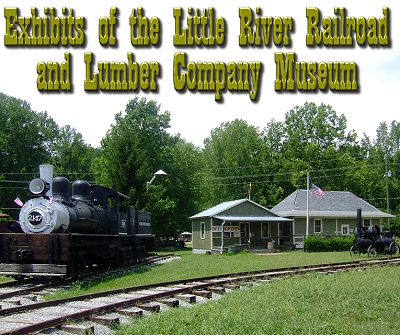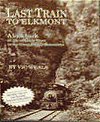 | |||
 |
 |
 | |
 |
 | ||
 |
 | ||
 |  | ||
 |  | ||
 | |||
 |
 |
 | |
 |
 | ||
 |
 | ||
 |  | ||
 |  | ||
| Written by Paul D. Race for Family Garden Trains(tm) |

|
Exhibits of the Little River Railroad and Lumber Company MuseumThanks to diligent efforts of many individuals, some significant artifacts of the Little River Railroad and Lumber Company have been preserved, including:
The museum also hopes to build a replica of a passenger platform. These were covered waiting areas that were used instead of stations where the trains stopped for towns and resorts. The Steam Crane/Skidder - Although none of the steam cranes that the Little River Lumber Company used were preserved, the museum was able to acquire an identical The Setoff House - Remember the wooden cube-shaped houses that the railroad built to move wherever they needed temporary housing for their workers? When I got home, I realized that I didn't have a photograph of the museum's setoff house, except that I caught most of it in the photograph above. Does it still need restoration? Sure. Considering
The Walland Water Tank - The community water tank from Walland has also been salvaged and put up on new piers. Though technically it isn't a railroad water tank, it has a similar look, and the museum plans to give it a spout and other details to make it look more "railroadey." It certainly gets attention from the road, especially since the LRRR's name was painted on it during a volunteer effort in August, 2008, only a few weeks after our visit.
The museum's "Little Woody" caboose was originally converted from a boxcar for the L&N railroad about 1918. It spent the first part of its retirement as a cabin at a Boy Scout camp near Norris Dam, before being donated to the future museum a few decades ago. In 2008, it was being stored in the engine house because the roof needed repair. Shay 2147 - The museum's most unusual display, of course, is Shay 2147, one of the few standard gauge Shays remaining anywhere, and one of the last locomotives to run on the Little River Railroad.
The Shay locomotive was invented by scholar, logger, and railroad entrepreneur Ephraim Shay. When his logging railroad had trouble with its locomotives, he brought a new perspective to a decades-old problem: how do you build a small, but powerful steam engine that doesn't literally pound the Although most Shay locomotives were built for narrow gauge logging or other industrial operations, the Little River Railroad's Shays were all standard gauge. Engine 2147 is a "three-truck" shay, a larger and less common example. In 1982, she was shipped at great expense from Robbinsville, North Carolina, where she had been awaiting the scrapyards. (When our family first saw her, she was at a temporary location, not on the present grounds of the museum.) In current photos you can see that part of the drive train has been disassembled to allow the locomotive to be pushed and pulled along the track as necessary. There is a plan for fixing that, rebuilding several structural parts, and replacing the cab, which is not original.
Frick Steam engine - The museum's portable Frick steam engine looks quaint today, but represents the Little River Railroad and Lumber Company's ConclusionAs you can see, the museum has done a pretty good job of rescuing important artifacts and making them available for display. Now that they have such fine pieces on the grounds (and a few smaller exhibits planned) the big jobs remaining include restoration and signage - I confess I didn't always know what I was looking at until I got home and started comparing the photos I took to articles on the museum's web site. It looks like their priorities have been preservation first and presentation second, exactly as they should be. Based on the little I know of their budget, they've done a lot on a shoestring, and I expect they will continue to spend wisely.If you are a fan of logging, of steam locomotives, or of Shays in particular, Townsend should be on your list of places to stop when you get to the Smokies. If you're in favor of educating the next generation about the practical value of railroads, this also seems to be a good project to support. Return to the Little River Railroad index page. Links for More Little River Railroad Information
The Museum's Home page: |


|

| 
|
 |
 |
 |
 |
 |
|
Note: Family Garden TrainsTM, Garden Train StoreTM, Big Christmas TrainsTM, BIG Indoor TrainsTM, and BIG Train StoreTM are trademarks of Breakthrough CommunicationsTM (www.btcomm.com). All information, data, text, and illustrations on this web site are Copyright (c) 1999, 2000, 2001, 2002, 2003, 2004, 2005, 2006, 2007, 2008, 2009, 2010, 2011, 2012, 2013, 2014, 2015, 2016, 2017, 2018, 2019, 2020, 2021, 2011, 2023 by Paul D. Race. Reuse or republication without prior written permission is specifically
forbidden.
For more information, please contact us |
 |  |